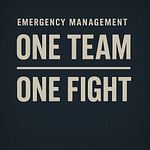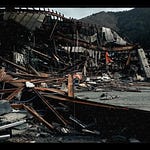
Sitting in front of the computer, thinking about what I should write about for this week's EMN Round-Up, I put on one of my favorite Jazz albums, Miles and Monk, at Newport Live 1958. This LP is an essential listen for everyone alive today! Jazz, in essence, is a group of very talented musicians, each a master of their instrument, coming together; they may have a set list, or they may not. They play off each other's strengths, and somehow, without any sheet music or a conductor, they produce a fantastic piece of music. (If you don’t like jazz, you can find the same type of collaborations with the Grateful Dead or Phish.)
Jazz music can teach us much about disaster response, as both involve improvisation, collaboration, and adaptation to changing circumstances. Here are a few ways in which jazz music can inform disaster response:
Improvisation: Jazz musicians are known for their ability to improvise and create music on the spot, without pre-planning or rehearsal. Similarly, in disaster response, it's important to improvise and adapt to changing circumstances, such as shifting weather patterns, unexpected road closures, or changes in the number of people needing assistance.
Improvisation is a hallmark of jazz music and an essential skill for musicians. In jazz, improvisation means creating music spontaneously, on the spot, without a pre-planned melody or score. Jazz musicians often rely on their knowledge of musical theory, scales, and chord progressions to create new melodies and harmonies in real time.
Improvisation is an essential skill in disaster response as well. Disaster situations are often unpredictable, and response efforts may require improvisation and creative problem-solving. Emergency managers must adapt to changing circumstances and develop innovative solutions.
One example of improvisation in disaster response is using a Joint Information System. The JIS brings together multiple agencies, organizations, and individuals to share information and coordinate messaging during emergencies. These systems provide a framework for Public Information Officers to work together and coordinate their efforts. JIS plans are flexible and adaptable, allowing PIOs to adjust their approach based on the circumstances of the disaster.

Another example of improvisation in disaster response is using technology to gather and share information. Social media platforms and other digital tools can help responders quickly collect and share information about the disaster, such as the location and severity of the damage, the number of people affected, and the resources needed for response efforts. This information can help responders make decisions and adjust their approach in real time.
In jazz music and disaster response, improvisation requires knowledge, skill, and creativity. By embracing improvisation, emergency responders can adapt to changing circumstances, find new solutions to complex problems, and help communities recover from disasters more quickly and effectively.
Collaboration: Jazz musicians often play in groups, each taking turns leading and following. Disaster response also requires collaboration, with different agencies and organizations working together to assist and support those affected by the disaster.
Collaboration is a crucial aspect of jazz music, as musicians often play together in groups, each contributing their unique talents and styles to create a cohesive sound. Similarly, collaboration is essential in disaster response efforts, as different agencies and organizations must work together to provide effective assistance and support to those affected by the disaster.
Effective collaboration in disaster response involves communication, coordination, and cooperation between different organizations and agencies. Collaboration can be challenging, as various organizations may have different protocols, procedures, and priorities. However, effective collaboration can improve response efforts by ensuring that resources are used efficiently and that assistance is delivered to those who need it most.
One example of collaboration in disaster response is using "multi-agency coordination centers" or MACCs. These centers bring together representatives from different organizations, such as emergency management agencies, non-governmental organizations, and private sector companies, to coordinate response efforts and share information. MACCs can ensure that resources are used effectively, reduce duplication of efforts, and improve communication and coordination between different organizations.
Another example of collaboration in disaster response is the use of public-private partnerships. Private sector companies can provide valuable resources and expertise in disaster response efforts, such as transportation, logistics, and communications equipment. Public-private partnerships ensure that resources are used efficiently and that assistance is delivered to those who most need it.
Collaboration in disaster response requires teamwork, respect for different organizations' protocols and procedures, and effective communication and coordination. By working collaboratively, different organizations can leverage their unique strengths and resources to provide more effective assistance and support to those affected by disasters.
Flexibility: Jazz musicians are skilled at adapting to different styles and genres of music and the different musicians they may be playing with. Similarly, in disaster response, it's important to be flexible and adaptable to the situation's needs, including the needs of different communities, cultures, and languages.

Flexibility is the key aspect of jazz music, as musicians are often required to adapt to different styles and genres of music and the different musicians they may be playing with. Similarly, flexibility is essential in disaster response efforts, as response efforts must adapt to changing circumstances and the needs of different communities, cultures, and languages.
Flexibility in disaster response involves adjusting response efforts based on the specific circumstances of the disaster, as well as the needs and resources of the affected communities. This may include adapting response efforts to the cultural and linguistic needs of the affected communities, such as providing language interpreters or culturally appropriate food and shelter.
One example of flexibility in disaster response is "community-based disaster preparedness." This approach involves working with local communities to identify their needs and resources and develop disaster preparedness plans that reflect their unique circumstances. By involving local communities in disaster preparedness efforts, response efforts can be more effective and better adapted to the community's needs.
Another example of flexibility in disaster response is using "adaptive management" approaches. This involves regularly evaluating response efforts and making adjustments as needed based on feedback from affected communities and response workers. By using adaptive management approaches, response efforts can be more effective and better adapted to the specific circumstances of the disaster.
Flexibility in disaster response requires a willingness to listen to and work with affected communities and adjust response efforts based on changing circumstances. By being flexible and adaptable, response efforts can be more effective and better able to meet the needs of the affected communities.
Resilience: Jazz musicians face challenges and setbacks, such as mistakes or technical difficulties, but they continue to play and adapt to the situation. Similarly, disaster response requires resilience in the face of setbacks and challenges, such as limited resources or unexpected complications.
Resilience is a crucial aspect of jazz music. Musicians often face challenges and setbacks, such as complex chord progressions or unexpected tempo changes, but can overcome these challenges and continue playing. Similarly, resilience is essential in disaster response efforts, as responders may face physical, emotional, and logistical challenges but must be able to adapt and continue providing support and assistance.
Resilience in disaster response involves being able to overcome challenges and setbacks, as well as being able to recover from the physical and emotional toll of responding to a disaster. This may involve providing responders with mental health and emotional support and ensuring they have the necessary resources and equipment to stay safe and healthy during response efforts.
One example of resilience in disaster response is "psychological first aid." This approach involves providing emotional and mental health support to affected communities and responders in the immediate aftermath of a disaster. By providing psychological first aid, responders can help individuals and communities begin the process of recovery and build resilience.
Another example of resilience in disaster response is using "building back better" approaches. This involves working with affected communities to recover from a disaster and improve their resilience to future disasters. By building back better, communities can become more prepared and better able to withstand future disasters.
Resilience in disaster response requires a willingness to overcome challenges and setbacks and a commitment to supporting responders' and affected communities' physical and emotional well-being. By building resilience, responders can continue providing effective support and assistance to those affected by disasters.
Jazz music can teach us valuable lessons about responding to disasters with creativity, collaboration, and adaptability.
Jazz music can teach us important lessons about disaster response. Collaboration, flexibility, and resilience are vital aspects of jazz music and disaster response efforts. By working collaboratively, adapting to changing circumstances, and building resilience, disaster response efforts can be more effective and better able to meet the needs of affected communities.
Effective disaster response requires a multidisciplinary approach involving collaboration between different organizations and agencies and a willingness to listen to and work with affected communities. Responders can ensure that response efforts are tailored to affected communities' specific needs and circumstances by taking a flexible and adaptive approach to disaster response.
Building resilience is also essential in disaster response, enabling communities to recover from and better prepare for future disasters. By providing emotional and mental health support to affected communities and responders and working with communities to build back better, responders can help build resilience and create more sustainable communities.
Overall, the lessons that can be learned from jazz music about collaboration, flexibility, and resilience are essential for anyone involved in disaster response efforts. By incorporating these lessons into response efforts, responders can provide more effective support and assistance to those affected by disasters and help build more resilient communities for the future.













Share this post